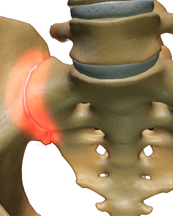What are the Symptoms of Sacroiliitis?

Sacroiliitis is a painful condition caused by an injury, disease, degeneration or inflammation of the sacroiliac joint, the joint in the lower spine that connects the spinal column to the pelvis and transfers power and force between the legs and the spine. Symptoms of sacroiliitis include pain in the pelvis or buttocks, low back pain, and pain in the hip or groin area and in the lower extremities. Other sacroiliitis symptoms are numbness, tingling, and or weakness in the legs, unilateral leg instability (that is, affecting only one side), as well as discomfort when sitting, and difficulty in finding a comfortable position in bed. Sacroiliitis can also affect mobility, causing an individual to limp, for example. But the symptoms of pain aren’t sufficient to make a diagnosis of sacroiliitis, because many other parts of the spine, when injured, irritated or diseased, can cause similar sensations of lower back pain, including the lumbar discs, nerve roots, and posterior facet joints. This can make the sacroiliitis diagnosis difficult. Physicians may use local anesthetic blocks to determine if the true source of the pain is derived from the sacroiliac joint or some other area of the spine. But many physicians simply treat for the more common problems and look for sacroiliac joint pathology only after the first treatment fails to correct the patient’s condition.
Treating Sacroiliitis Symptoms
In fact, many patients have often undergone workup and received treatment and therapies for other lumbar spine problems or hip disorders, including surgery on the lumbar spine or hips, before the correct diagnosis is made. Indeed, patients who have had lumbar spine or hip surgery yet have not experienced symptomatic relief could be suffering from inflamed sacroiliac joint dysfunction and sacroiliitis.
Fortunately, once the correct diagnosis is made, a number of treatments are available, including a new minimally invasive surgical procedure that is making a remarkable difference for sacroiliitis patients who don’t respond to more conservative therapies. We’ll talk about treatment options for sacroiliitis in our next blog.






